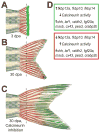Keeping at arm's length during regeneration
- PMID: 24780734
- PMCID: PMC4052447
- DOI: 10.1016/j.devcel.2014.04.007
Keeping at arm's length during regeneration
Abstract
Regeneration of a lost appendage in adult amphibians and fish is a remarkable feat of developmental patterning. Although the limb or fin may be years removed from its initial creation by an embryonic primordium, the blastema that emerges at the injury site fashions a close mimic of adult form. Central to understanding these events are revealing the cellular origins of new structures, how positional identity is maintained, and the determinants for completion. Each of these topics has been advanced recently, strengthening models for how complex tissue pattern is recalled in the adult context.
Copyright © 2014 Elsevier Inc. All rights reserved.
Figures



References
-
- Adams DS, Masi A, Levin M. H+ pump-dependent changes in membrane voltage are an early mechanism necessary and sufficient to induce Xenopus tail regeneration. Development. 2007;134:1323–1335. - PubMed
-
- Blum N, Begemann G. Retinoic acid signaling controls the formation, proliferation and survival of the blastema during adult zebrafish fin regeneration. Development. 2012;139:107–116. - PubMed
-
- Broussonet PMA. Observations sur la regeneration de quelques parties du corps des Poissons. Hist de l’Acad Roy des Sciences 1786
Publication types
MeSH terms
Grants and funding
LinkOut - more resources
Full Text Sources
Other Literature Sources

